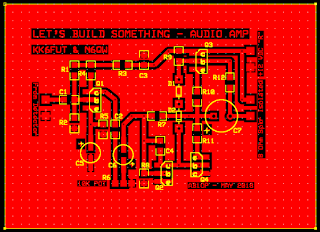22nd of May, 2018 Hope everyone is enjoying Spring!
Watched as much W5KUB coverage of Hamvention 2018 last weekend as was allowed by the XYL and the ever present "Honey Do" list. Been busy in Real Life so bench activity has suffered.
New Project - MiniPA 70 watt HF Amplifier Kit
These kits are current available on eBay for $15-25 USD under various headings.The Pluses:
- Small
- Runs on a 13.8Vdc supply.
- Cheap
- Comes with NO DOCUMENTATION - Need to go online even for the schematic.
- Not Complete - Need to buy several other components to have a working Amp
.
https://www.youtube.com/watch?v=CeegQYZ25J0
http://pa-11019.blogspot.com/2016/11/diy-kits-70w-ssb-linear-hf-power.html
http://www.oe1cgs.at/wp-content/uploads/2018/02/50W-HF-PA.pdf
https://www.dk9jc.de/blog/equipment/142-diy-kits-70w-ssb-linear-hf-power-amplifier-ft-817-kx2-kx3
Google "SSB HF 70W AMP" key words for latest links.
NOTE: What is NOT included
(Needed to make a working HF Linear Amplifier for Amateur Radio.)
- HeatSink
- Thermal Paste (Heatsink Compound)
- Bolts / machine screws (6) to mount PCB and TO-220's to Heatsink.
- 12Vdc Fan
- Enclosure
- Panel mount SO-239 connectors
- Power supply connector
- Power Switch
- Fuse and Holder
- Low Pass Filter for desired Ham band(s)
- RCA female panel connector for PTT
- 50 Ohm COAX and Hookup wire
- Power on LED (optional)
MiniPA 70 watt HF Amplifier: Unboxed
Here is the kit parts all laid out:
As usual with Chinese kits no documentation is included, all parts were loose packed in a bubble wrap bag (no ESD protection for FETs) Two extra TO-220 insulation pads and washers were included.
The PCB is only about 2" x 4" inches - my kit had all the SMD components already soldered to the PCB, some of these kits do not so "buyer beware" check auction listing closely, an extra $2 may save you 2 hours of bench time.
The PCB also has Die-cut pieces that are cut out for the T1 & T2 transformer core assemblies.
MiniPA 70 watt HF Amplifier: Assemble the T1 & T2 transformer cores
Here is the Transformer cores ready to solder the tubes to the PCB pieces
Transformer cores after soldering the PCB pieces to the tubes.
Checking PCB for fit on Heatsink I brought










